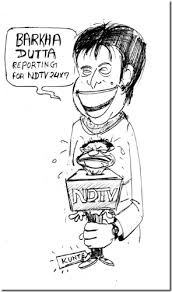
This column must begin by acknowledging that perhaps some of the ire directed against Barkha Dutt susbsequent to the release of the ‘Radia tapes’ is unfair. Barkha, as she never fails to point out, is but one of the many journalists, and public figures who have compromised themselves through their conversations with Nira Radia. To focus entirely on Barkha would be to forget about the other significant issues that this scandal has revealed. Nevertheless Brakha Dutt’s responses raise significant issues that are worth probing independently.
 First, the force of the backlash against Dutt should be seen as a backhanded compliment. It was only because Barkha actually attempted to, and (sadly) succeeded in representing herself (and NDTV) as the face and voice of the nation, that the shock of the Radia tapes has ricocheted on to her in this manner. As the old saying goes, the bigger they are, the harder they fall. It is to this monumental significance that NDTV and Barkha Dutt sought to achieve that this column will refer when discussing some of the ethical issues that emerge from this case, and Barkha seems unwilling to address.
First, the force of the backlash against Dutt should be seen as a backhanded compliment. It was only because Barkha actually attempted to, and (sadly) succeeded in representing herself (and NDTV) as the face and voice of the nation, that the shock of the Radia tapes has ricocheted on to her in this manner. As the old saying goes, the bigger they are, the harder they fall. It is to this monumental significance that NDTV and Barkha Dutt sought to achieve that this column will refer when discussing some of the ethical issues that emerge from this case, and Barkha seems unwilling to address.
This discussion of the issue takes as its focus the interaction engineered by NDTV between the editors of various print media and Barkha Dutt. In this discussion, despite a suggestion from one of the editors that ‘we all make mistakes, one can say sorry and move on’, Barkha seemed to obstinately refuse this possibility. All that she was willing to admit to was, ‘an error of judgment’. This seems like the first steps towards an apology, but the mea (maxima) culpa was significantly absent.
Both Barkha and various persons in support of her have more or less argued that her conversations with Nira Radia constitute the way Delhi works. There are a number of people who want favours in return, and to get the information that one wants, one has to ‘string them along’ even if one will not in fact do so. The suggestion that they make, is that to act as a go-between, to trade favours is not ethical, and hence they refrain from  acting in such a manner. Let us concede for the sake of argument that these journalists are in fact sticklers for such ethics. But is one able to keep stringing this person along ad infinitum? And if one is able to do so, what are the ethics regarding the relationship with the person you string along? Are these persons occupiers of significant positions of power, or are they smaller cogs in the larger mechanism, hoping that the trade of these small details will give them the dignity that is otherwise denied to them? Let us not forget that the political mechanism in India (and publicly on display in darbar style in Delhi) is one that is built on an hierarchy of humiliation and material deprivation. Such stringing along then, ultimately amounts to an abusive relationship with people who may be unable to retaliate.
acting in such a manner. Let us concede for the sake of argument that these journalists are in fact sticklers for such ethics. But is one able to keep stringing this person along ad infinitum? And if one is able to do so, what are the ethics regarding the relationship with the person you string along? Are these persons occupiers of significant positions of power, or are they smaller cogs in the larger mechanism, hoping that the trade of these small details will give them the dignity that is otherwise denied to them? Let us not forget that the political mechanism in India (and publicly on display in darbar style in Delhi) is one that is built on an hierarchy of humiliation and material deprivation. Such stringing along then, ultimately amounts to an abusive relationship with people who may be unable to retaliate.
Journalism and journalists occupy a central position in democratic societies because of the belief that they will speak truth to power; that through presentation and discussion of critical issues in  the public fora they will maintain the vitality and spiritual purity of the democracy. The practice of democracy then, rests not only on the periodic elections, and the honest functioning of elected officials, but also on the ethical behaviour of the democracy’s journalists. In the case where Nira Radia is a peddler of corporate interests what would be the ethical response of a democratic journalist? The response would rely on the recognition of a number of factors. First, that a democratic polity is in fact constituted to further the interests of ‘the people’. These ‘people’ are not the fictional personalities that private corporations are, but the real people who vote governments and politicians into power. These interests are further not the interests of either the majority or minority, but of the ensuring a uniform and just access to resources to sustain livelihoods. This access is eventually enabled through the sustaining of working democratic systems, where one is not allowed to take short cuts based on who you are, who you know, or on how much money you have.
the public fora they will maintain the vitality and spiritual purity of the democracy. The practice of democracy then, rests not only on the periodic elections, and the honest functioning of elected officials, but also on the ethical behaviour of the democracy’s journalists. In the case where Nira Radia is a peddler of corporate interests what would be the ethical response of a democratic journalist? The response would rely on the recognition of a number of factors. First, that a democratic polity is in fact constituted to further the interests of ‘the people’. These ‘people’ are not the fictional personalities that private corporations are, but the real people who vote governments and politicians into power. These interests are further not the interests of either the majority or minority, but of the ensuring a uniform and just access to resources to sustain livelihoods. This access is eventually enabled through the sustaining of working democratic systems, where one is not allowed to take short cuts based on who you are, who you know, or on how much money you have.
What is galling about Barkha’s response that ‘this is the way Delhi works’ is that she seems willing to allow the system to work the way it does. She will play the game, since otherwise she would not get any information. This is however not her fault. She is the member of a profit-making organization, and while democracy is good, it cannot be allowed to get in the way of the generation of profits. Its action is not to speak truth to power, but to not get in the way of the functioning of power, and ideally get in bed with it. Indeed, a careful observer of NDTV presentations will indicate how they have continuously flaunted their access to power, whether it is through referring to Union Ministers by first name when conducting interviews, or through their body language that suggests an off-screen camaraderie, or at least the desire for such.
If Barkha were to conform to the ethical position of the democratic journalist,  then her ideal response when first propositioned by Radia would have been to respond, ‘I’m sorry Radia, but I think you’re approaching me in this manner is unethical and I would be forced to include such propositions as part of my coverage.’ Matter ended. We are not obliged to always follow the ethical position, because admittedly real life is somewhat more complex than the ideal ethical positions. But the beauty of a legal system (and ethics is a certain kind of legality), is that you are free to ignore the law, but when you get caught, at the very least you acknowledge your mistake, and pay the price for the transgression. Further, an ethical system is never ideal. It is always opposed to the ways of the world. But this gap between reality and the ideal is critical. It is this gap, that allows for the realization of utopia. Without the gap, there would be nothing to challenge the status-quo. And the status-quo, based as it is on power, is always oppressive.
then her ideal response when first propositioned by Radia would have been to respond, ‘I’m sorry Radia, but I think you’re approaching me in this manner is unethical and I would be forced to include such propositions as part of my coverage.’ Matter ended. We are not obliged to always follow the ethical position, because admittedly real life is somewhat more complex than the ideal ethical positions. But the beauty of a legal system (and ethics is a certain kind of legality), is that you are free to ignore the law, but when you get caught, at the very least you acknowledge your mistake, and pay the price for the transgression. Further, an ethical system is never ideal. It is always opposed to the ways of the world. But this gap between reality and the ideal is critical. It is this gap, that allows for the realization of utopia. Without the gap, there would be nothing to challenge the status-quo. And the status-quo, based as it is on power, is always oppressive.
Barkha Dutt fails to show remorse or acknowledge her guilt apart from an  ‘error of judgment’. Given that in the interaction with the editors she presented herself as a ‘political journalist’ suggests to us that either her understanding of a democracy is rather shallow, or she is wholly committed to a different form of political arrangement; an oligarchy. A system of democratic values holds no particular significance for her. In addition it forces us to ask the question if both NDTV and Barkha Dutt would prefer to persist in the lie that they dispassionately represent the nation; that their presentation of news and views is not deliberately slanted to favour the oligarchically-inclined class (regardless of the red herring that political party represents) from which they emerge and belong to.
‘error of judgment’. Given that in the interaction with the editors she presented herself as a ‘political journalist’ suggests to us that either her understanding of a democracy is rather shallow, or she is wholly committed to a different form of political arrangement; an oligarchy. A system of democratic values holds no particular significance for her. In addition it forces us to ask the question if both NDTV and Barkha Dutt would prefer to persist in the lie that they dispassionately represent the nation; that their presentation of news and views is not deliberately slanted to favour the oligarchically-inclined class (regardless of the red herring that political party represents) from which they emerge and belong to.
(A version of the post was first published in the Gomantak Times dated 8 Dec 2010)

